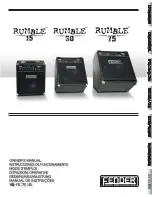
00043972.DOC, Version 1.2
32/36
8 OPERATION
8.1 Selecting the operating mode
Select the operating mode with the selector switch OPERATION MODE:
• position
BRIDGE
:
bridge operation (The input signal of channel A is additionally switched to channel 2.
1 signal at channel 2 is ignored and volume adjustment is made with the level control
for channel 1.)
• position
PARALLEL
: parallel operation (The input signal of channel 1 is switched in parallel to channel 1
and channel 2. A signal at channel 2 is ignored and volume adjustment is made with
the level controls for channel 1 and 2.)
• position
STEREO
:
stereo operation (both channels are operated independent of each other)
8.2 Switching on/off
To prevent loud switching noise, always switch on all other units of the amplifier system before switching on
the power amplifier. After operation, switch off the power amplifier first. Prior to switching on set both level
controls to the left stop position. Then switch on the amplifier with the power switch. The protection indicators
light up for about 10 seconds. If they do not, check if the amplifier is connected to the mains correctly. After
the turn-on delay the speakers are activated (protection indicators are off). Afterwards the power indicator
ON lights up and indicates that the amplifier is switched on. In parallel mode the indicator PARALLEL lights
and in bridge mode the indicator BRIDGE lights.
8.3 Adjusting the level
1
First, set the volume controls of the pre-amplifiers to zero and turn both gain controls of the amplifier to
mid-position. There should be no loud humming. Should humming persist, check the connection cables
between the pre-amplifier and the amplifier (switch off components before).
2
With the selector switch SENSITIVITY the input sensitivity of the amplifier can be matched to the output
level of the preceding unit.
3
Adjust the level controls to the desired volume value. If the SIGNAL indicator lights the input sensitivity is
about 0.35 V. In case of overload, the red CLIP indicator lights up. In this case, reduce the volume
correspondingly.
4
In parallel or bridge mode the level control for channel 2 is disabled. Volume adjustment is made with the
level control for channel 1.
Additional information on the operation
When operating the amplifying system, please make sure that the loudspeakers always sound well. When
distortions can be heard, either the amplifier or the loudspeaker is overloaded. Overloads can quickly lead to
amplifier or speaker damage. In order to avoid damage, please reduce the volume immediately when distortions
can be heard. When speaker systems are destroyed by overload, the guarantee becomes void. Always check the
sound pressure level with a meter in order to keep to the threshold.
8.4 Switching on the limiter
With the selector switch LOW FREQ ENHANCED it is possible to boost the low bass range. For this purpose
set the switch to the upper position ON.
9 PROTECTIVE CIRCUITS
The integrated protective circuits prevent damage to the speakers and the amplifier. If activated, the
speakers are electrically separated from the amplifier and the PROTECT indicator lights up:
•
for
around 10 seconds after switching-on until the speaker outputs are ready for operation
•
in case of overheating of the amplifier
•
in case of a VHF signal at a speaker output
•
in case of a short-circuit at a speaker output
•
in case of a DC voltage at a speaker output
If the red PROTECT indicator lights up during operation or if it does not extinguish after switching on, the
amplifier has to be switched off and the cause of the fault has to be removed.





































